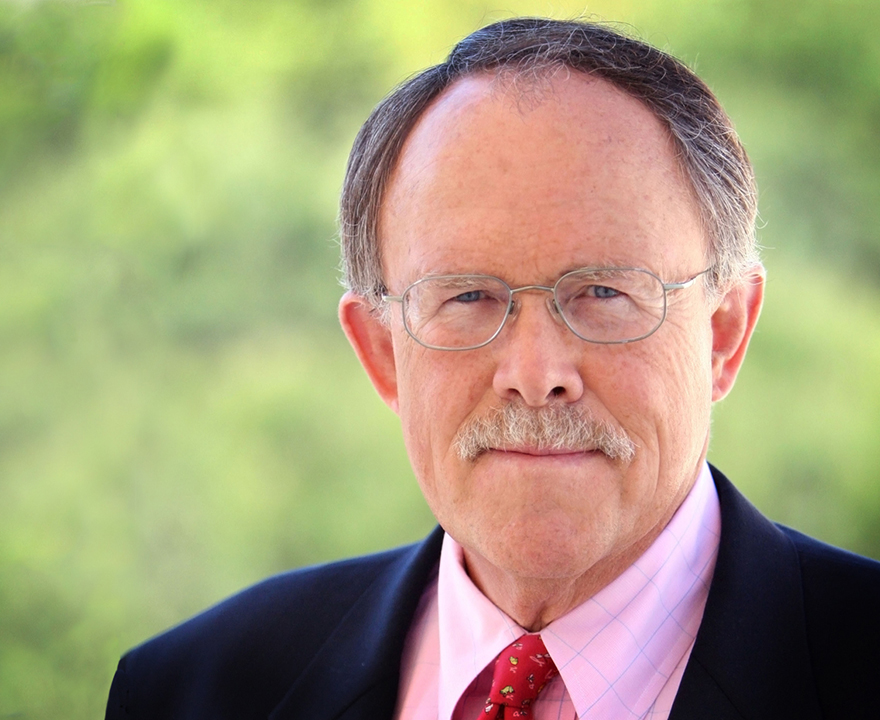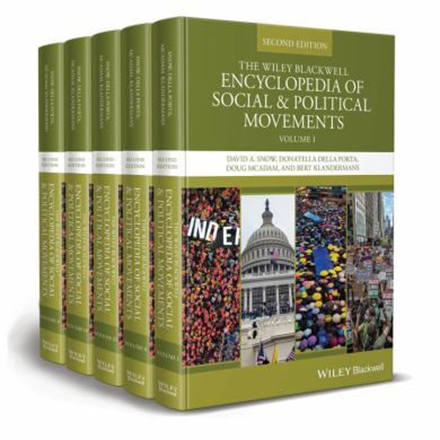
The Wiley Blackwell Encyclopedia of Social and Political Movements
 From Black Lives Matter to the January 6 attack on the U.S. Capitol, social protests
and collective action initiatives over the past decade have played a critical role
in shaping societal discourse and debate. In The Wiley Blackwell Encyclopedia of Social and Political Movements, 2nd Edition, UCI sociologist David Snow and co-editors expand their comprehensive collection on
movements and the social worlds in which they emerge and operate to include new analyses
on contemporary topics. With more than 600 entries on initiatives spanning political
and religious oppression to socioeconomic and rights-based inequalities, the second
edition provides a timely update on movements across the U.S. and worldwide. Below,
Snow explains why the decennial update was necessary, what general themes he’s observed
studying social protest and collective action, and which “long haul” movement he feels
has made the most significant difference.
From Black Lives Matter to the January 6 attack on the U.S. Capitol, social protests
and collective action initiatives over the past decade have played a critical role
in shaping societal discourse and debate. In The Wiley Blackwell Encyclopedia of Social and Political Movements, 2nd Edition, UCI sociologist David Snow and co-editors expand their comprehensive collection on
movements and the social worlds in which they emerge and operate to include new analyses
on contemporary topics. With more than 600 entries on initiatives spanning political
and religious oppression to socioeconomic and rights-based inequalities, the second
edition provides a timely update on movements across the U.S. and worldwide. Below,
Snow explains why the decennial update was necessary, what general themes he’s observed
studying social protest and collective action, and which “long haul” movement he feels
has made the most significant difference.
What inspired you to create such an extensive reference work on social and political movements?
The inspiration for the encyclopedia derives from the observation that many of the most significant social and political developments and changes throughout much of human history – such as the ascendance of Christianity and Islam, the Reformation, and the American, French, Russian and Chinese Revolutions, for example – are in part dependent on an understanding of the workings and influence of social movements. This observation is equally relevant when we consider the impact of social movements in relation to various social, cultural, and political challenges and changes across the world over the past 150 years or so. In doing so, it is reasonable to wonder how very different things might have been in the absence of the international anti-slavery movement, the suffrage movement, the labor movement, and the various civil and human rights movements. All these movements played an important role in the establishment and deepening of citizenship rights in some countries, are still operative in other countries that have yet to guarantee such rights, and are now being challenged across the globe by a surge in anti-democratic, autocratic movements. Needless to say, the importance of social movements and protest is strikingly evident in the contemporary world as well, as amply illustrated by many of the entries in the encyclopedia.
It’s been 10 years since the first three-volume series was published. What prompted the update now?
The rationale for the updated and expanded 2nd edition is much the same as for the 1st edition: the ongoing river of events that courses through the globe continues to include numerous instances of aggrieved collectivities of various size and scale pressing relevant authorities to attend to their associated grievances and demands, ranging from political and religious oppression to socioeconomic inequalities to procedural and/or rights-based inequalities to all kinds of lifestyle concerns and perceived social and environmental harms. For illustration, we need only look to the unsettling events that unfolded in the U.S. in 2020 and 2021. On May 25, 2020, the police killing of George Floyd in Minneapolis set in motion the largest, most diverse sustained protests in U.S. history. Orchestrating much of that protest was the Black Lives Matter movement, which had emerged seven years earlier in 2013 and gained prominence in 2014 after the unwarranted police killings of a number of Black men. And then there was the shocking January 6, 2021, assault on the nation’s capital, incited by the sitting President, Donald Trump, who remains a potent, albeit toxic, political force in the U.S. There was also no shortage of unrest and social movement activity in many other countries around the globe. In Chile, massive protests in 2019 led to deep transformation in the political landscape. In Hong Kong as in Catalonia, millions of citizens mobilized for independence through often innovative forms of protest. In Europe, the effects of the Indignados wave of anti-austerity protests remain visible in a transformation of the electoral landscape. A surge in right-wing populist and autocratic movements posed a threat to liberalism and democracies throughout much of the world. A new wave of feminist struggles addressed sexual abuse and violence against women as well as opposing a neoconservative backlash that threatened gender rights. And as extreme weather events escalated sharply around the globe, so too did instances of climate activism. As well, the pandemic crisis triggered various forms of contentious politics, including protests against lockdowns, mask wearing, and vaccines. So there has been an abundance of social movements and their protest events that have populated the sociocultural and political landscape nationally and globally since publication of the 1st edition in 2013.
What challenges did you encounter? In particular, with more than 200 new entries added in the second edition, how did you decide which cultural and political developments to include?
Obviously, selectivity was involved, since there is no assembled worldwide population of social movements from which to sample. But the movements and related events included were not selected haphazardly. Rather, we selected 11 Advisory Editors who have specialized knowledge of social movements and related activities in different regions of the world – for example, Africa, Central and South America, Eastern Asia (China, Japan, Korea, Taiwan), Europe, and the United States. Additionally, we also wanted to include major theoretical perspectives, concepts and processes, and relevant research methodologies and procedures; so we also selected our Advisory Editors with an eye to ensuring coverage of the major perspectives and concepts and different types of movements. In short, we tried to assemble a team of Advisory Editors that, in combination with the four editors, ensured sufficient regional diversity and scholarly research breadth to compile a comprehensive, authoritative, interdisciplinary, up-to-date encyclopedia on social and political movements that would be an invaluable reference volume for students and scholars of social movements worldwide. Thus, the coverage, even though necessarily selective, is broad-based such that major social and political movements and protest events throughout segments of history and across the globe are among the entries.
What general themes emerged among the movements you included since the 1st edition?
I think the most general theme over the past 10 years has been rise and confluence of three strands of movements: pluralism, particularly on the political right, with its anti-democratic and authoritarian thrust, as manifested, for example, in the movements associated with Orbán in Hungary, Erdoğan in Turkey, Modi in India, and even Trump in the U.S.; the resurgence and internationalization of white supremacist movements, including neo-Nazi and anti-immigration movements, and their popularization and dissemination of “the great replacement” frame; and the ascendance of religious nationalist movements as with the Christian nationalist movement in the U.S. The contemporaneous rise and spread of these and related movements is not coincidental. Rather, these movements exist in a mutually supportive symbiotic relationship, as evident with Putin’s reinvigoration and political exploitation of the Russian Orthodox church, Modi’s embrace of Hindu nationalism, and the strategic, reciprocal alignment between Trumpism, the white supremacy movement, and the evangelical movement and its embrace of Christian nationalism.
If you had to pick only one social movement that has made the most significant difference in your lifetime - or our lifetime - what would it be and why?
I would say the Civil Rights Movement (CRM). And by that I mean not just the so-called classical phase of the CRM, that ranged from the Montgomery bus boycott of December 1955 to Martin Luther King Jr.’s death in April 1968, but the long struggle for equal rights among African Americans that began toward the end of the 19th century through Jim Crow and continues to this very day. There are a number of reasons for the historic significance of this movement, but two stand out for me. First, the enduring, persistent struggle for securing and maintaining equal civil rights reminds us that many movements are “long haul movements” in that their struggles are ongoing. Advances may be achieved, as with the civil rights legislation of 1964 and ’65, but new roadblocks and countermovements surface that require renewed protest and challenge as we see again today. And second, the CRM came to function as a kind of animating algorithm, what’s called a “master frame” in the movement literature, for subsequent rights-based movements, such as the women’s movement, various ethnic-based movements, the LGBTQ movement, the disability rights movement, and so on. In other words, it provided both a discursive and strategic model for pressing for a disadvantaged group’s claims and demands. This is not to say that these other movements didn’t make their own specific discursive and strategic adaptations given the contexts in which they operated, but the CRM provided an enduring model of persistence and challenge.
The Wiley Blackwell Encyclopedia of Social and Political Movements, 2nd Edition is co-edited by David Snow, Distinguished Professor emeritus of sociology, UCI; Donatella della Porta, professor of sociology and dean of the faculty of political and social science, Scuola Normale Superiore (Italy); Doug McAdam, The Ray Lyman Wilbur Professor of Sociology, Stanford University; and Bert Klandermans, professor of applied social psychology, Vrije Universiteit (the Netherlands).


